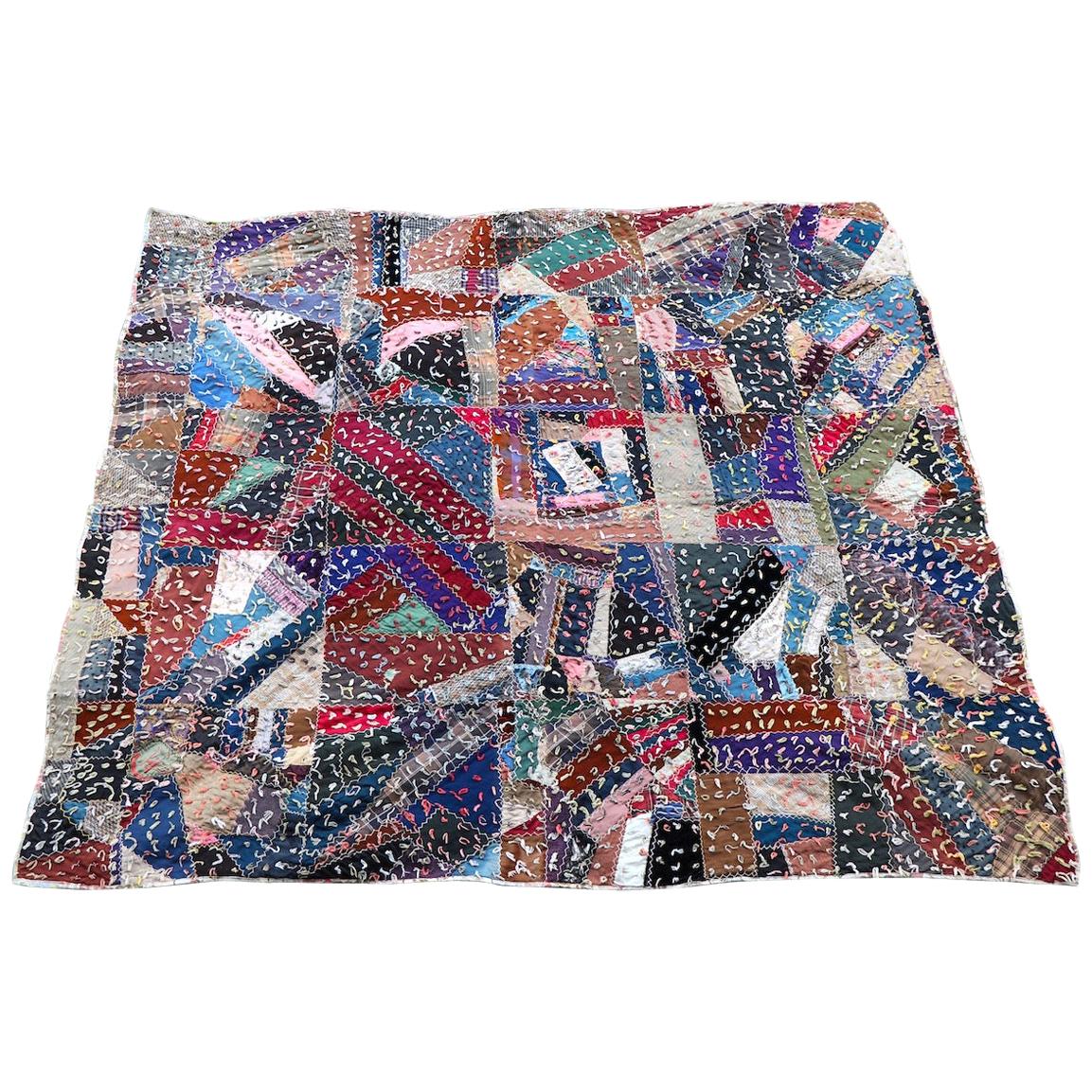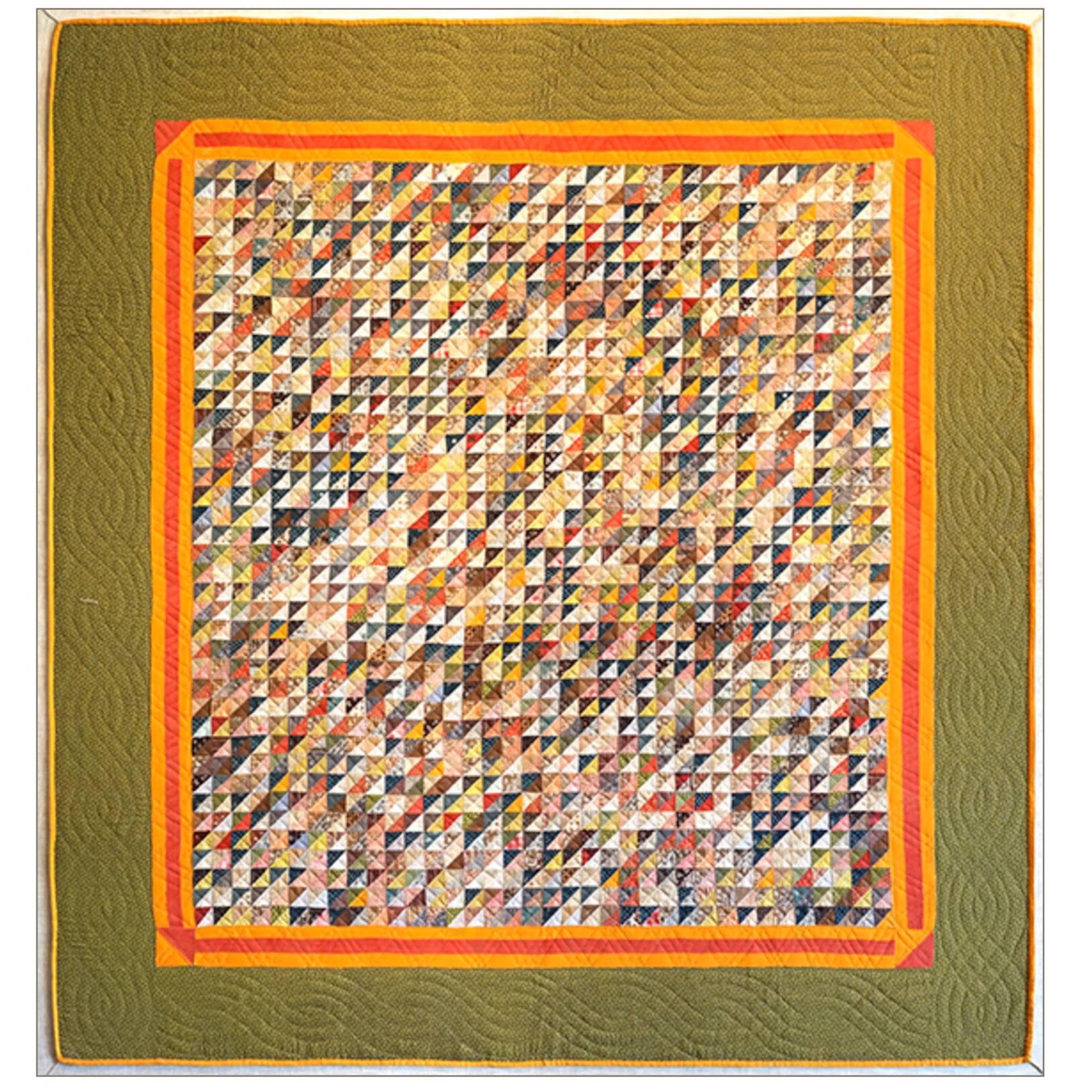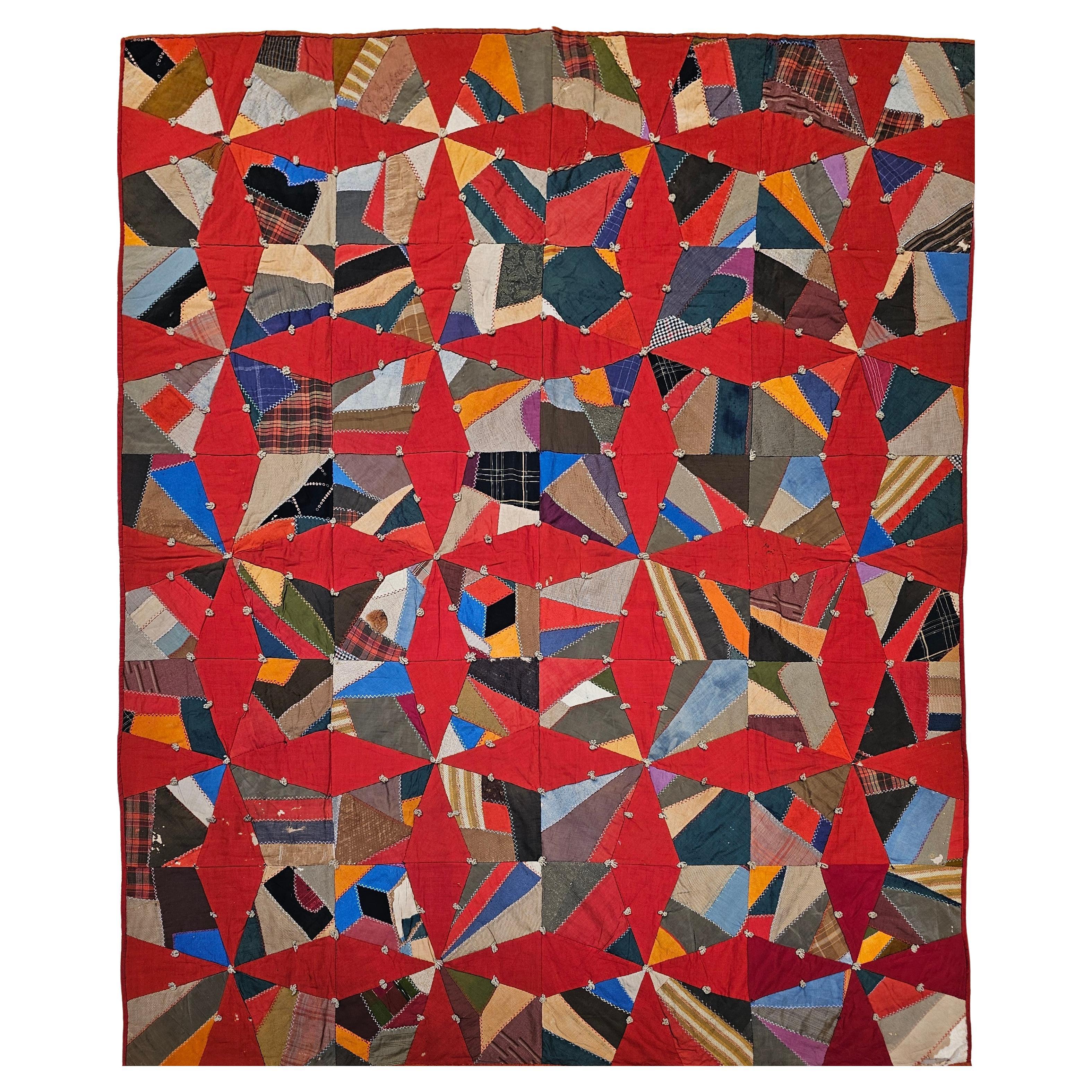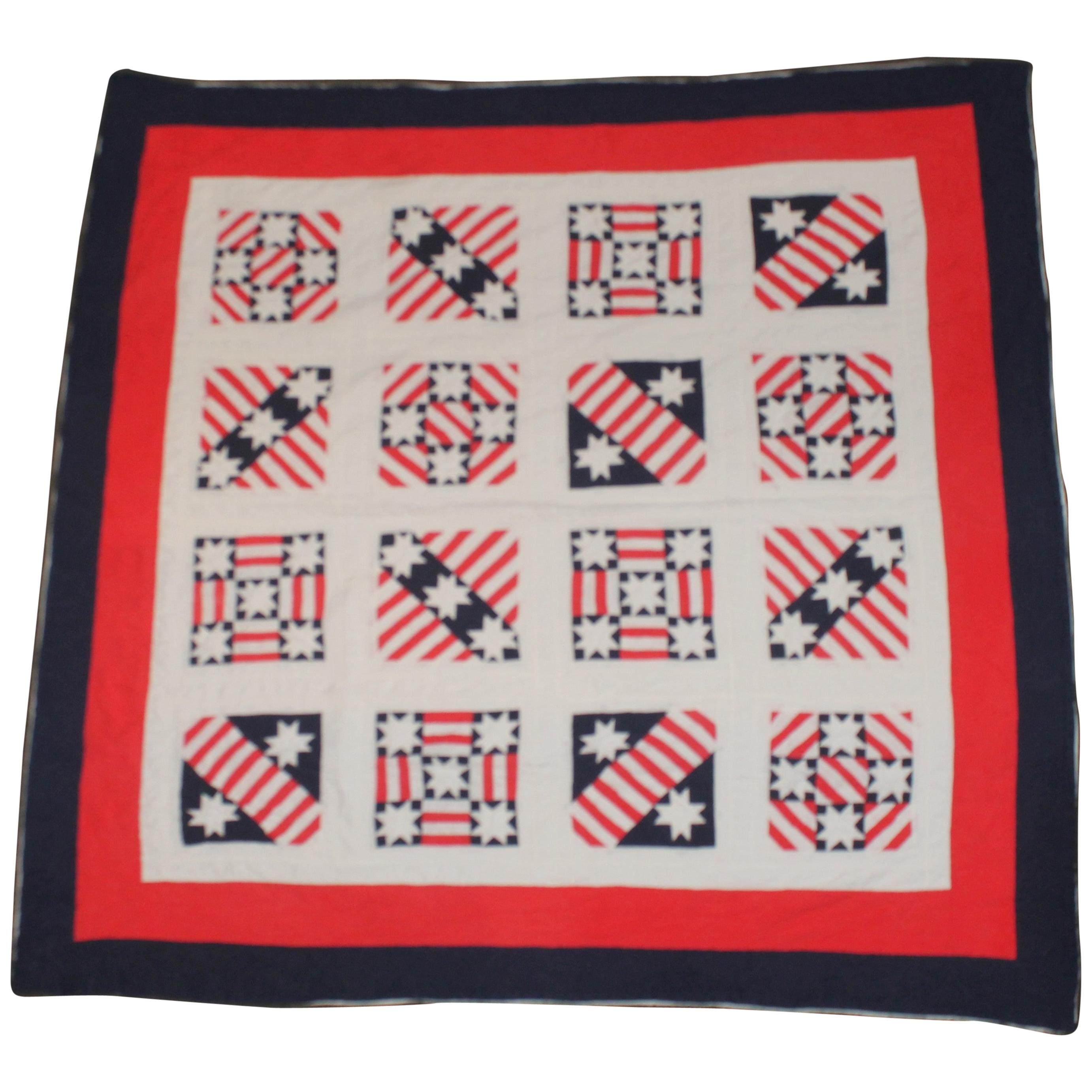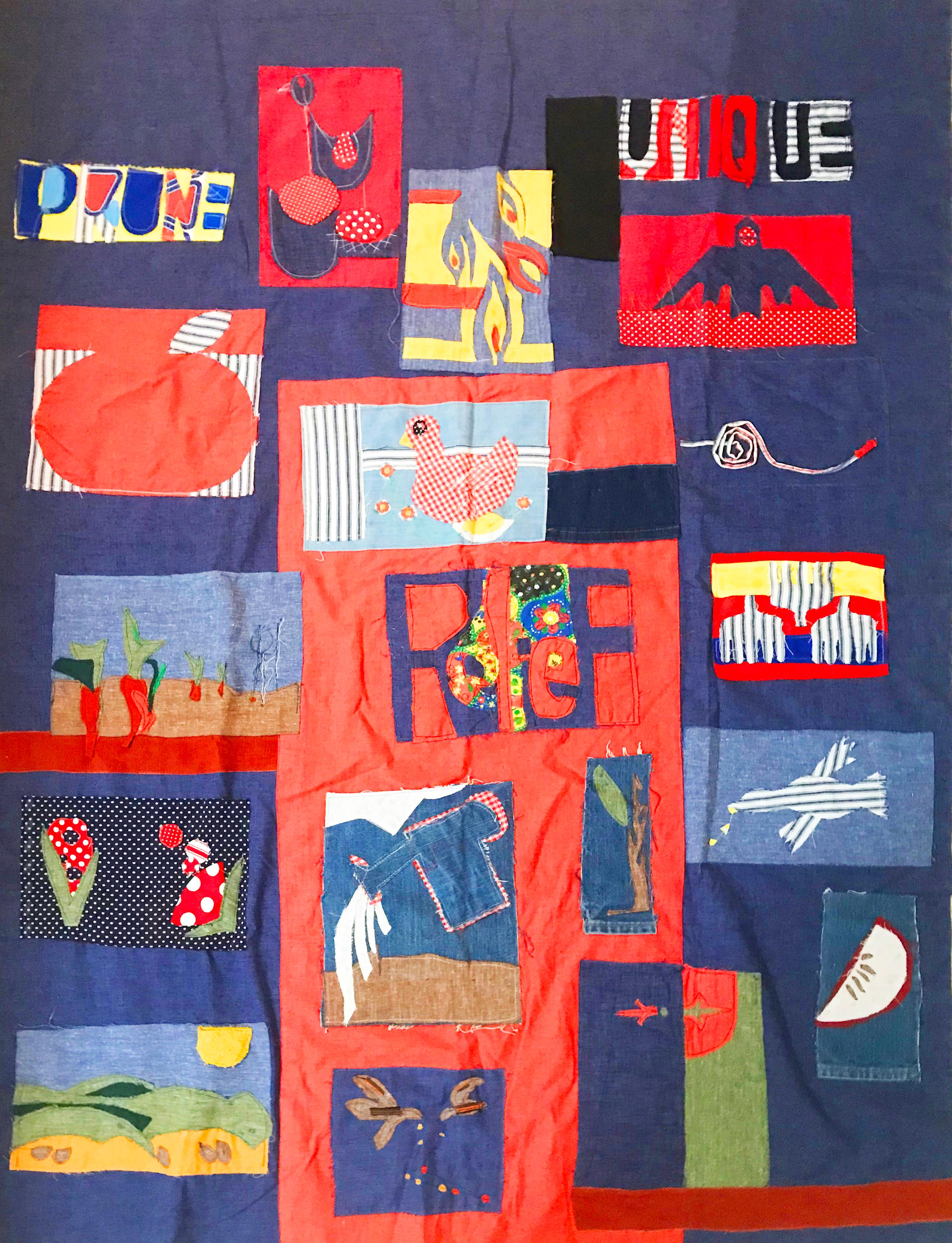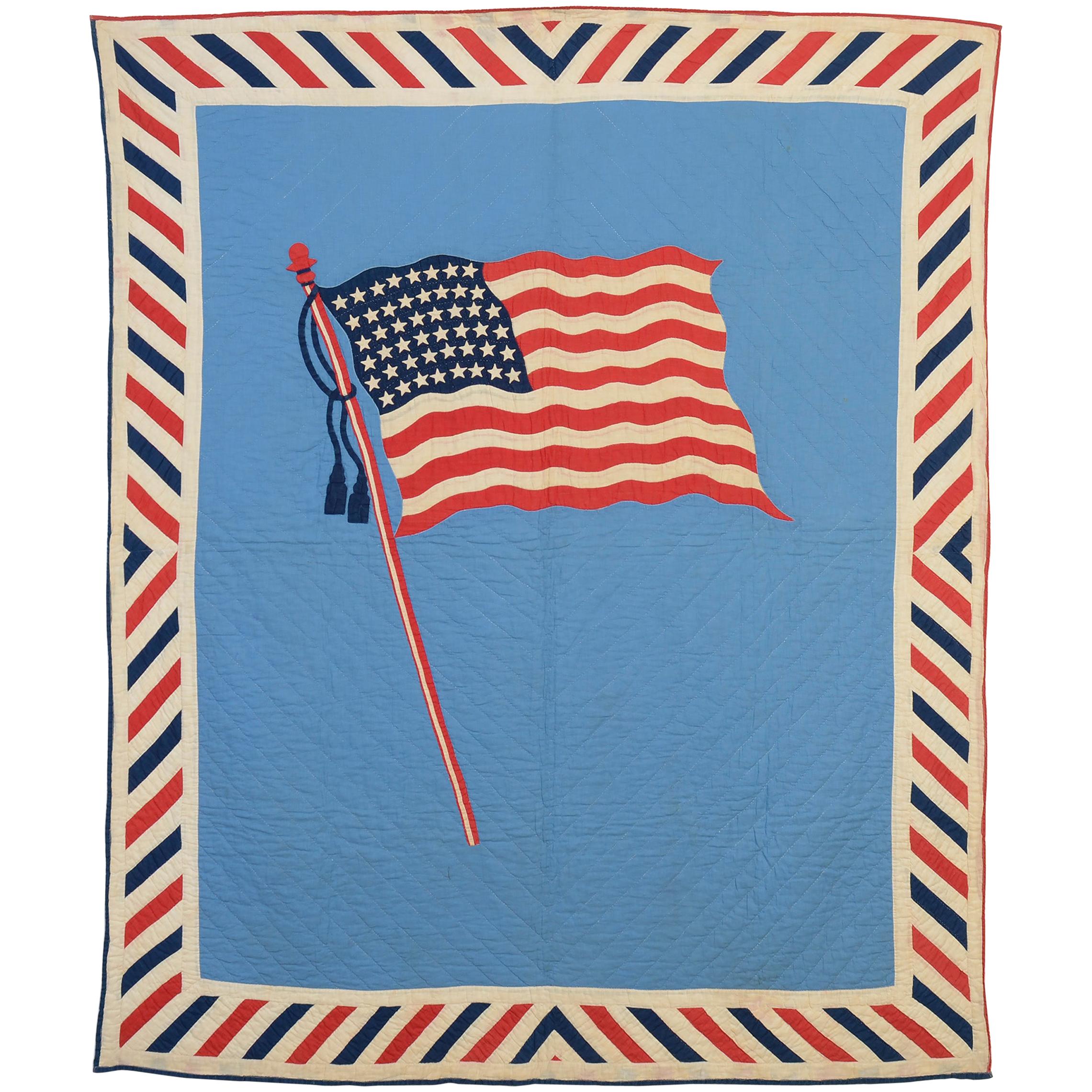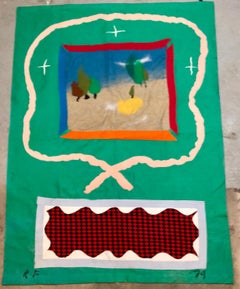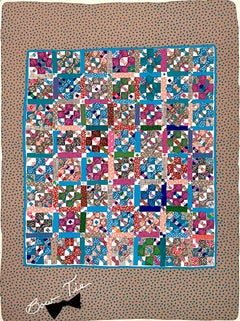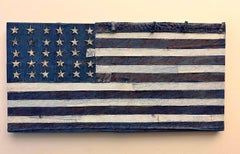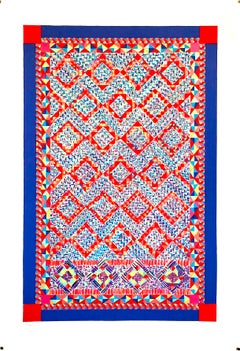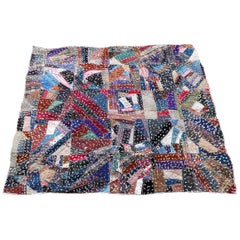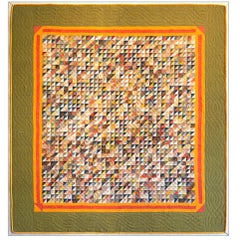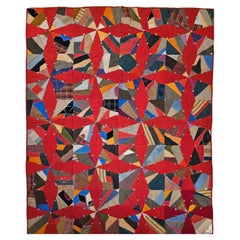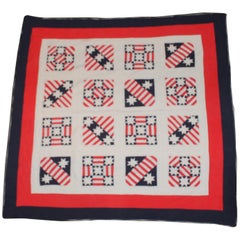Items Similar to Abstract Red Blue Folk Art Americana Flag Can Tapestry Quilt Ross Palmer Beecher
Want more images or videos?
Request additional images or videos from the seller
1 of 21
Ross Palmer BeecherAbstract Red Blue Folk Art Americana Flag Can Tapestry Quilt Ross Palmer Beecherc.1988
c.1988
$4,850
£3,600.87
€4,196
CA$6,733.37
A$7,531.69
CHF 3,919.54
MX$92,717.72
NOK 49,864.64
SEK 46,782.86
DKK 31,306.35
Shipping
Retrieving quote...The 1stDibs Promise:
Authenticity Guarantee,
Money-Back Guarantee,
24-Hour Cancellation
About the Item
Ross Palmer Beecher (born 1957)
Hand signed in sharpie on the verso.
Dimensions: 19.5"w x 17"h.
A unique contemporary found object assemblage tapestry made of Pepsi with Olympics logo, Sunkist, Budweiser Beer, Seltzer, Coca Cola Classic, White Rock and Hawaiian Punch aluminum soda cans by American artist Ross Palmer Beecher. The artist wove together elements of cans to create a small sculptural wall hanging in a quilt like pattern. The Pepsi logos become decorative hearts, which allows the viewer to see these everyday logos as a fine art object.
Ross Palmer Beecher (1957- ) is a contemporary mixed media woman artist who creates quilts, flags, portraits of famous film directors and American folk heroes, and other types of objects from welded copper pennies to aluminum cans and found objects. She lives and works in Seattle.
This is in the style of the great artist from Ghana, El Anatsui as well as African artists Romuald Hazoumè, and Willie Bester. They are among the artists best known for their work with recycled materials.
Ross Palmer Beecher was born in Greenwich, Connecticut, in 1957. (Her name was Dawn Beecher). Ross Palmer Beecher grew up in Riverside, CT. Her Puerto Rican grandfather, a Yale educated attorney, married her Ziegfeld dancer grandmother. Her parents worked in advertising and communications, but loved cocktail parties and sailing. She studied painting, printmaking, and illustration at the Rhode Island School of Design in Providence. (RISD) She left school after two years to move to Seattle in 1978 where she took odd jobs, "deli work, parking cars, and working in a laundromat". She began to make political cartoons as hand-colored Xerox prints at Pike Place Market before she made found object art.. In 1980 she began making woodcut prints and metal quilts as art, connecting to her New England roots. After multiple odd jobs, she began creating metal and mixed media wall sculptures from materials she found while riding her bicycle in Seattle: "gas caps, bottle caps, auto tail light fragments, and empty soft drink cans". In the mid 1980s, "folk art-inspired exhibitions in Texas, Illinois, Louisiana, and California" invited her participation. She accepted a position in 1993 as Artist in Residence at Bailey-Boushay House for patients with HIV/AIDS.
Beecher’s strict formal control and rigid symmetry are the foundational skeleton of her art. However, within the quilt grids, all hell breaks loose: spirals, sunbursts, maze shapes, diamonds and circles all have their day as our apprehension of each piece reveals license plates, paint tubes, olive oil cans, aerosol paint cans and other cast-offs. Her work incorporates bullets, military and denim fabric, and screws in collage and assemblage creations. Beecher's art has been well-received by critics.
This one has a patriotic quality in red white and blue. Her artworks gained regional and national attention in galleries, museums, and private and public art collections. While her art is inspired by American folk art forms such as "quilting, flag-making, bricolage, and primitive portraiture", she is not a folk artist. In 1999, Matthew Kangas outlined Beecher's personal and artistic development over the 17-year period after she left the Rhode Island School of Design. Matthew Kangas wrote that her early art has links to the work of unlettered artists but is "quirky enough (in technique and subject) to separate her out from true Outsider art or folk art". Judy Wagonfeld of the Seattle Post-Intelligencer said of her work, "Stitching scavenged fabric, textile, wood and metal, she crafts offbeat flags and Americana rife with satire. What appears simple turns convoluted. It's as though you order a corn dog and get esoteric polenta with prosciutto". According to Wagonfeld, her works pay homage to the folk art genre, while satirizing the elitist art world, and her glitzy metal quilts honor women's work as art. She joined the Greg Kucera Gallery in 1986, where she has had more than ten one-person exhibitions and been exhibited in many thematic exhibitions. Reviewing a 2014 installation at Greg Kucera Gallery in Seattle, Kangas noted Beecher's art is "an utterly unique amalgam of folk art, Pop Art and engaged social-political art". Kangas notes her largest works are a "nod, both droll and commemorative to Jasper Johns and Joseph Albers". Her work seems to me more like a feminist modern version of Anni Albers.
Selected exhibitions
Quilts, Greg Kucera Gallery, Seattle (2014)
Black Art, Seattle Art Museum, Seattle, curated by Sandra Jackson Dumont (2008)
Art of Recycling, Hallie Ford Museum, Salem, Oregon (2006)
Art in Embassies Program, US Embassy, Austria (2006)
AMERICANA: Quilts, Flags and Famous Folk, Greg Kucera Gallery, Seattle (2003)
The Great Film Directors, Bank of American Gallery, Seattle (2000)
San Francisco Airport Exhibition, San Francisco (1989)
Awards:
Betty Bowen Memorial Award (Seattle Art Museum, 2002)
Artist Trust fellowship (2005)
- Creator:Ross Palmer Beecher (1957, American)
- Creation Year:c.1988
- Dimensions:Height: 17 in (43.18 cm)Width: 19.5 in (49.53 cm)
- Medium:
- Movement & Style:
- Period:
- Condition:
- Gallery Location:Surfside, FL
- Reference Number:1stDibs: LU38214883902
About the Seller
4.9
Platinum Seller
Premium sellers with a 4.7+ rating and 24-hour response times
Established in 1995
1stDibs seller since 2014
1,777 sales on 1stDibs
Typical response time: 1 hour
- ShippingRetrieving quote...Shipping from: Surfside, FL
- Return Policy
Authenticity Guarantee
In the unlikely event there’s an issue with an item’s authenticity, contact us within 1 year for a full refund. DetailsMoney-Back Guarantee
If your item is not as described, is damaged in transit, or does not arrive, contact us within 7 days for a full refund. Details24-Hour Cancellation
You have a 24-hour grace period in which to reconsider your purchase, with no questions asked.Vetted Professional Sellers
Our world-class sellers must adhere to strict standards for service and quality, maintaining the integrity of our listings.Price-Match Guarantee
If you find that a seller listed the same item for a lower price elsewhere, we’ll match it.Trusted Global Delivery
Our best-in-class carrier network provides specialized shipping options worldwide, including custom delivery.More From This Seller
View All70's Large Colorful Abstract Expressionist Art Protis Tapestry Wool Wall Hanging
By Robert Freimark
Located in Surfside, FL
Art Protis Wall Tapestry
Robert Freimark (1922 - 2010)
Bob Freimark was active/lived in Ohio, California, Michigan. Robert Freimark is known for abstract expressionist painting, ...
Category
1970s Abstract Expressionist Mixed Media
Materials
Wool
Mixed Media Collage Feminist Lithograph Folk Art Quilt Pattern & Decoration Art
Located in Surfside, FL
Bow Tie
Hand signed and numbered, ,limited edition lithograph collage assemblage.
Barbara Kohl-Spiro is a Milwaukee, Wisconsin-based artist whose work has spanned over five decades...
Category
20th Century Folk Art Mixed Media
Materials
Fabric, Lithograph
Vintage 1970s Pop Art Americana Patriotic American Flag Denim Jeans Hand Sewn
By Jean Jacques de la Verriere
Located in Surfside, FL
Pop Art American Flag in Handsewn Patchwork Denim.
I had another with a label from OK Harris Gallery verso. This one does not have that label or the label Label from Pratt verso (Pratt MFA '75)
Not positive of the year
Hand signed
Genre: Modern
Medium: Denim Jean Textile Fabric, Mixed Media
Country: United States
Dimensions: 14 X 28 inches
This is a textile wall hanging tapestry "painting" made from vintage jeans.
JJ had a masters (MFA) from Prat and studied at Hunter college for many years. He was a master jeweler and goldsmith for 50 years, a musician and a photographer. He made a living working with photography, jewelry, bronze sculpture and antique restoration. An artwork in denim fabric by a French Post War & Contemporary artist living in New York City, Jean de la Verrière, An untrained, art brut, 'outsider' artist, now 85. He sold some of his denim patriotic flag works through OK Harris gallery in Soho in the 1980s, one went directly to Ralph Lauren, according to the artist. He is also known for sculpture. particularly his working model, fully functional guillotine sculptures. Artist says he was influenced by Pop Art particularly Robert Rauschenberg and Jasper Johns works. He was in the New York art world along with his artist friends Bernar Venet, Arman and Claude Gillie. He fabricated and cast jewelry for some of his friends. This has a Sterling Ruby feel to it but was done a generation earlier. This is assembled like a quilt and was influenced by early American folk art. Jean Jacques De La...
Category
20th Century Pop Art Mixed Media
Materials
Cotton, Cotton Canvas, Found Objects, Mixed Media
Quilt or Persian Rug Serigraph Pattern and Decoration Feminist Lithograph Print
By Dee Shapiro
Located in Surfside, FL
Dee Shapiro is a Contemporary American artist and writer associated with the Pattern and Decoration movement. I have seen this referred to as Hejaz.
Dee Shapiro was inspired to be an Artist in her early years of education. Dee's career started in the 1970s as a pattern painter with her works of art included in the Pattern and Decoration at P.S. 1
(other artists included Mary Grigoriadis, Valerie Jaudon, Joyce Kozloff, Robert Kushner, Kim MacConnel, Miriam Schapiro, Betty Woodman, Robert Zakanitch.)
She researched and explored the Fibonacci Progression in color on graph paper and also explored geometric complexity of architectural designs, leading her to create the small horizontal oil paintings of cities and landscapes. Dee Shapiro became a Yaddo fellow in 2017.
Dee Shapiro obtained her bachelor's degree in 1958 and Master of Science in 1960 from Queens College, City University of New York. Dee Shapiro is an artist that sees the subject on a large scale, but what she creates is on a diminutive scale. Shapiro's strength is the ability to give expressive power on canvas that makes her work seem larger than they are. Dee Shapiro has been a teacher, lecturer, and writer through career. "I have been concerned with women’s issues most of my life. I have worked to enhance the position of women in society through supporting the work of women artists. As a contributor to Heresies Magazine and a founder of a women’s cooperative gallery as well as developing a body of work that references women’s work and more currently focuses on female sexual imagery, I identify with feminist matters and affairs."
Group exhibitions
2018 The American Dream, Emden, Germany
Solo exhibitions
2016 Art 101, Brooklyn, NY
2015 Andre Zarre Gallery, NYC
2015 Five Points Gallery, Torrington, CT
2012, 2010, 2009 Andre Zarre Gallery, NYC
2010 Norfolk Library, Norfolk, CT
2009 George Billis Gallery
2006 Harrison Street Gallery, Frenchtown, NJ
2004 The Mercy Gallery. Loomis Chafee, Windsor, CT.
2004,2002, 1998 Andre Zarre Gallery, NY C, National Arts Club, NYC
2000 Principle Gallery, Alexandria, VA
1998 Nassau County Museum of Fine Art, Roslyn, NY
1997 Andre Zarre Gallery, NYC
1996 North Winds, Port Washington, NY
1994, Andre Zarre Gallery, NYC
1984 Ana Sklar Gallery, Miami, FL
1983 Andre Zarre Gallery, NYC
1982 Everson Museum, Syracuse, NY, Andre Zarre Gallery, NYC
1981 Dubins Gallery, Los Angeles, CA, Zenith Gallery, Pittsburgh, PA
1980, 1976 Andre Zarre Gallery, NYC
1979 Gallery 700, Milwaukee, WI Andre Zarre GalleryNYC
1978 St. Mary's College, Notre Dame, IN
1977 University of Arkansas, Little Rock, AK
1975, 1973 Central Hall Gallery, Port Washington, NY, Nassau County Museum of Fine Art, Roslyn, NY
Selected bibliography
James Panero, Supreme Fiction The Hudson River School Revisited, March, 2010
Piri Halaz, From the Mayor’s Doorstep, April 2010
Steve Starger, Art New England, Dee Shapiro: “On The Horizontal,” Feb/Mar 2005
Maureen Mullarkey, The New York Sun,”The Last Time I Saw Cuba,” April 15, 2004
James Kalm, NY ARTS, International Edition, April 2000
Helen Harrison...
Category
1980s Abstract Geometric Abstract Prints
Materials
Screen
1970 Abstract Oil Painting "the Patriot" Red White Blue Assemblage Art Lou Fink
By Lou Fink
Located in Surfside, FL
Lou Fink
The Patriot
Oil on canvas, 1970 (mixed media with iron lock)
Provenance: Collection of The Southampton Hospital Association, Southampton, New York.
This abstract expressionist painting entitled "the Patriot" is done in patriotic shades of red, white and blue in a color field pattern reminiscent of Mark Rothko. It has an assemblage, collage, lock installed at its center, with great color and texture.
This piece has a sculpture quality to it.
Louis R. Fink (1925 - 1980) American modernist artist.
He lived in Staten Island, New York. Lou Fink is known for abstract painting, collage and assemblage
Education
Art Students League (studied with Harry Sternberg, Louis Bosa, and John C. McPherson)
Solo Exhibitions:
1955 Wagner College Studio-Gallery, Staten Island
1960-1980 Environment Gallery, N.Y., seven one-man shows
1981 Elaine Benson Gallery, Bridgehampton, N.Y., Memorial Exhibition
Group Exhibitions:
1949 Art Students League (works by disabled GI Bill students)
1952-54 Art Institute of Chicago, International Exhibition of Contemporary Drawing (traveling exhibition)
1955 Pennsylvania Academy of the Fine Arts, Annual Exhibition
1956 National Academy of Design, 131st Annual Exhibition
1956 Museum of Modern Art, "Recent Drawings— U.S.A." (along with Andy Warhol, Josef Albers, Louis Schanker, Larry Rivers, John Levee, Varujan Boghosian, Morris Graves and Herbert Bayer.)
1957 Staten Island Museum, Annual Spring exhibition
1959 Columbia (South Carolina) Museum, Audubon Artists exhibition
1969 Environment Gallery Louis Fink, Frank Manuela, Richard Banks, Phillip Lloyd Powell
1980 Gallery Kyoto, Japan,
1987 Elaine Benson Gallery, Bridgehampton, “Remembering”
Lou Fink made Christmas card designs for Tiffany...
Category
1970s Abstract Abstract Paintings
Materials
Metal
Red White Blue Americana Wall Hanging Painting Sculpture American Flag Motif
Located in Surfside, FL
Painted wood wall hanging sculpture
"Red, White and Blue," (and gold) 2008
Stamped signed with initials, date and edition 2/5
Oded Halahmy, Abstract Modernist artist, was born in Iraq in the old city of Baghdad in 1938, the artist came from a family of Orthodox Jews with deep roots in ancient Babylonian culture. His father, Salech Haskel Chebbazah, was a prosperous goldsmith in Baghdad and a Jewish member of the Communist Party when Jews comprised more than a quarter of the population of Baghdad. He refers to his home as the “land of wheat, barley, grapes, figs, pomegranates, olives and dates.”, Oded moved with his family to Israel in the 1950s, was educated at St. Martin's School of Art in London which was then a leading center for sculpture, led by Anthony Caro and Philip King and having links to Henry Moore. He taught sculpture are in the collection of the Guggenheim Museum, the Hirshhorn Museum, and the Israel Museum in Jerusalem, as well as many other public and private collections worldwide. He currently lives in New York City and Old Jaffa, Israel.
Like countless New Yorkers who arrived from distant lands, Oded Halahmy has a rich personal history of exile, migration and travels. Although New York has been his home for over 45 years, memories of Iraq left an indelible imprint on his life and work. Known for his dynamic yet often playful figurative pop art style sculptures in wood and bronze, he fills his work with images — albeit abstracted from reality — that evoke the landscape, architecture and rich colors of the Middle East. Palm trees, doves, pomegranates, temples and age-old symbols abound along with deep reds, amber, sky blue and the familiar greenish-blue hues of aged bronze.
SELECTED SOLO EXHIBITIONS
Dates-Pomegranates-Olive Oil: Chanukah Lamps, Yeshiva University Museum, New York, NY
District of Columbia Jewish Community Center Ann Loeb Bronfman Gallery, Washington, D.C.
Homeward: Baghdad - Jerusalem - New York, Sundaram Tagore Gallery, New York, NY
Homelands: Baghdad-Jerusalem-New York, A Retrospective, The Ann Loeb Gallery, Washington,
Homelands: Baghdad-Jerusalem-New York, A Retrospective, Yeshiva University Museum, NY
The Common Ground; The Sculpture Of Oded Halahmy, Sundaram Tagore Gallery, New York, NY
Herr-Chambliss Fine Arts, Hot Springs, AR
Artists Studio, Old Jaffa, Israel
Byer Museum of Art, Evanston, IL
The Aldrich Museum of Contemporary Art, Ridgefield, CT
Tomasulo Gallery, Union College, Cranford, NJ
Martha White Gallery, Louisville, KY
Louis K. Meisel Gallery, New York, NY
New England Center for Contemporary Art, Brooklyn, CT
Hebrew Union College, New York, NY
Bicentennial Tribute, United States Federal Plaza, New York, NY
Horace Richter Galleries, Jaffa, Israel, 1976
Parsons School of Design, New York, NY
America-Israel Culture House, New York, NY
Herbert F. Johnson Museum of Art, Cornell University, Ithaca, NY
Louis K. Meisel Gallery, New York, NY
Gallery Moos, Toronto, Canada
Old Jaffa Gallery, Jaffa, Israel
Pollack Gallery, Toronto, Canada
SELECTED GROUP EXHIBITIONS
2006 Iraqi Art...
Category
Early 2000s Pop Art Figurative Paintings
Materials
Wood, Paint
You May Also Like
Graphic Antique Tied Quilt
Located in New York, NY
Graphic 19th century American tied quilt in very fine, original condition.
Unusual construction includes densely tied surface, piecework is handstitched, e...
Category
Antique 19th Century American Country Quilts
Materials
Fabric
Monumental Micro Triangular Cut Feed Sack Folk Art Quilt Mounted on Canvas
Located in Buchanan, MI
Monumental micro triangular cut feed sack Folk Art quilt mounted on canvas. All hand stitched, amazing details. Perfect for great room with high ceilings. ...
Category
Antique Late 19th Century Folk Art Quilts
Materials
Fabric
19th Century American Crazy Quilt with Red Stars
Located in Barrington, IL
An exceptional late 19th-century American Crazy Quilt, hand-pieced, hand-stitched, and hand-tied with remarkable artistry and attention to detail. Likely originating from Pennsylvania and discovered in the New England region, this textile masterpiece is composed of individually hand-cut fabric pieces arranged in an abstract, improvisational pattern—a hallmark of the Crazy Quilt tradition. The quilt is accented by vivid red star motifs, contrasted with a lively mix of blues, grays, and multicolor fabrics. Each seam is enhanced with herringbone embroidery, adding textural richness and craftsmanship. Finished on a soft flannel cotton backing, this quilt blends bold visual energy with cozy materiality. Traditionally used as decorative throws, Crazy Quilts are renowned for their artistic spontaneity and historical charm. This piece is ideal as wall art or as a standout accent in a curated interior.
Dimensions: 67” x 84”
Date of Manufacture: 4th Quarter of the 1800s
Place of Origin: United States
Material: Wool, Cotton
Condition: Wear consistent with aged and use
The Persian Knot Gallery, SKU: 2200
19th century crazy quilt, antique American crazy quilt, red star quilt, hand-tied crazy quilt, herringbone embroidery quilt, Pennsylvania crazy quilt, flannel-backed quilt, Victorian era quilt, colorful folk art textile, collectible antique quilt, hand-stitched crazy quilt, vintage abstract quilt, late 1800s textile, crazy quilt wall art, heirloom American quilt, decorative antique throw, American Crazy Quilts, Vintage Crazy Quilts, Pennsylvania Quilts, Amish Quilts, Vintage Raising Barn Quilt, Vintage Log...
Category
Antique Late 19th Century American Quilts
Materials
Wool, Cotton
$1,520 Sale Price
20% Off
Patriotic Red, White and Blue Quilt Dated
Located in Los Angeles, CA
This fun patriotic red, white and blue quilt is in very good with slit fade condition in areas. It had a paper label with a signature and dated 1986. Late b...
Category
Late 20th Century American Country Quilts
Materials
Cotton
$1,036 Sale Price
20% Off
"Unique" Folk Art Style Hand Made Tapestry
By Bill Condon
Located in Houston, TX
Tapestry of a collection of brightly color abstract scenes titled "Unique" by Bill Condon. The piece is made out of various fabric pieces stitched onto light denim fabric.
Artist Bi...
Category
20th Century Folk Art Mixed Media
Materials
Tapestry
Patriotic Flag Quilt Old Glory
Located in Darnestown, MD
Nothing could be more of the moment than this patriotic flag quilt depicting Old Glory.
It was most likely made either for the admission of Arizona into st...
Category
Early 20th Century American Folk Art Quilts
Materials
Cotton
More Ways To Browse
Vintage Metal Cans
Screw Art
African Primitive Art
Denim Art
Red Vintage Car
Small Dog Sculpture
Flag Diamond
Wood American Flag
License Plate
Wood Dog Sculpture
Vintage Mazer
Black And White Quilts
American Folk Art Wood House
Blue Dog Sculpture
Tapestry Dog
Vintage Hawaiian Wall Art
Metal Wall Sculptures 1980s
Vintage Metal Advertising Signs
